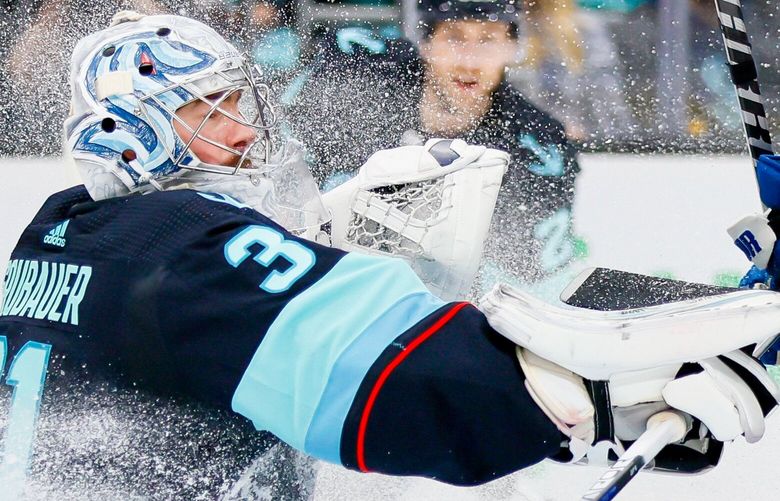Kraken forward Eeli Tolvanen claims that, while playing junior hockey in Iowa, he once slapped a puck into an opponent’s empty net from close range with the goalie pulled.
Tolvanen somehow escaped that night unharmed by opposing players but admits he wouldn’t dare try it in the NHL. And for good reason, given how Ottawa Senators rookie Ridly Greig was basically assaulted on the ice in February for doing the exact same thing. Toronto Maple Leafs defenseman Morgan Rielly didn’t appreciate Greig showing his team up and immediately charged over and cross-checked the Sens’ player in the face as he celebrated along the corner boards.
The attack on Greig and ensuing five-game suspension handed down on Rielly sparked intense debate about unwritten NHL rules pertaining to overly enthusiastic handling and celebrating of an empty-net goal.
“I think it’s just common sense — the game’s over, you’ve got a two-goal lead and you’ve just got to respect each other,” Tolvanen said, adding he’s not really sure what prompted his own slapper into an unguarded net when he was 16 and had first arrived from Finland to play for Sioux City in the United States Hockey League.
“We battle hard on the ice, but when it comes to that kind of stuff, you’ve just got to kind of close the game. It’s mutual respect you show to everybody. It’s like, what would you like them to do to you? So, you don’t do a big celly, or a slap shot.”
Hockey etiquette has no problem with players trying to score on an empty net regardless of how much time remains. A tying goal can be scored in two or three seconds off a faceoff, so missing an empty-net chance and getting called for icing and forcing an own-end draw isn’t the preferred route.
For decades, there’s been an understanding at multiple levels of hockey that empty-net goals should be celebrated at a minimum unless clinching some huge game. When Maple Leafs captain George Armstrong scored perhaps the league’s most famous empty-net goal with 47 seconds to play in a 3-1 win that clinched Toronto’s last Stanley Cup title in Game 6 against Montreal in 1967, his entire team poured off the bench in celebration without any brawls being triggered.
But a player hooting and hollering and sliding back down the ice with his stick between his legs as if riding a horse after sealing a preseason victory might get himself mocked or even beat up at a future date. Generally, in such situations, the gesturing, stick pumping and vocals are all but eliminated.
As for how the goal should be scored, the general rule has always been to not hoist the puck high into the net when skating in for an unguarded, close-range opportunity.
In such situations, with no defenders around, players will often just guide or ease the puck along the ice into the net.
“I think it’s just being smart,” Kraken veteran Jaden Schwartz said. “I think it’s something that guys usually don’t take over the line.”
Schwartz can recall maybe “one or two” celebrations of empty-net goals that got cringeworthy, but said most players understand the context. “It’s kind of like an unwritten rule,” he said.
Same with shooting a puck at an empty net. The idea, he said, is to make sure the shot is headed at the net — not to add needless extra gusto to it.
“There’s a time and a place for everything,” he said.
One of the stranger and most confusing empty-net goal celebrations in recent memory came in January when Pavel Buchnevich of the St. Louis Blues slammed his stick in anger and broke it against the glass after scoring. Apparently, he was angry at himself for missing several earlier scoring opportunities — including a prior empty-net try — and wanted everyone to know he didn’t take the blown opportunities lightly.
Fortunately, the New York Rangers team he scored on seemed just as confused as everybody else and didn’t interpret his antics as a slight against them.
There’s no easier way to rub salt in an opponent’s wound than getting too carried away with the shot or celebration — called a “celly” by today’s players — in order to “send a message” to the defeated team. In Greig’s case, the message was interpreted as a huge middle finger to the Maple Leafs and their legions of visiting fans that had poured into Ottawa’s home arena.
Even Greig’s teammate, Josh Norris, seemed to understand the rookie had crossed some invisible line.
“You never know what Greiger’s going to do. I mean, I loved it,” Norris told reporters postgame. “But obviously, I’m sure if we’re on the other side of that, I don’t know if we would have liked that, either. I didn’t really like the retaliation. I understand their frustration, but it’s over with. And I guess it was entertaining.”
Toronto coach Sheldon Keefe said of Rielly’s subsequent response attack on Grieg: “I thought it was appropriate.”
Keefe, 43, was a major junior hockey star in the late-1990s when even looking at an opponent the wrong way might be considered a sign of disrespect and get you jumped. Nowadays, with fighting and self-policing by teams on the decline, many of hockey’s unwritten rules are being debated by a newer generation of fans and players that seem to covet the “celly” and showmanship more than predecessors.
For instance, it was once unthinkable for an NHL player to attempt a “Michigan” goal by lifting the puck with their stick behind an opponent’s net and doing a high wraparound move before tucking the puck into a top corner behind the startled goalie.
The “high wrap” lacrosse-type move was pioneered by minor league player Bill Armstrong and later copied by University of Michigan player Mike Legg in a 1996 NCAA tournament game. Still, the antic was considered bush-league by NHL players until Andrei Svechnikov of Carolina scored a “Michigan” goal in 2019, followed by Trevor Zegras of Anaheim netting a couple three years later and a third this season against Kraken goalie Joey Daccord.
While the “Michigan” used to infuriate opponents, it’s become tolerated and even celebrated. Zegras, 23 who has yet to score more than 23 goals in a season, wound up on the cover of the NHL 23 video game for his efforts.
Had Tolvanen tried a slap shot on an empty net from 20 feet away playing major junior hockey in the 1980s and 1990s he’d likely not have made it back to his bench in one piece. But when asked what happened to him when he did it in the USHL, he shrugged his shoulders.
“Nothing, really,” he said.
But Kraken forward Tye Kartye, 22, a part of the younger generation of players, said it’s still not the best idea to needlessly antagonize opponents once a game is out of reach.
“It’s usually just sportsmanship if you’re up by two or three,” he said. “You don’t sell it too hard.”
Editor’s note: This is the latest of an occasional series on the unwritten rules of hockey.


The opinions expressed in reader comments are those of the author only and do not reflect the opinions of The Seattle Times.